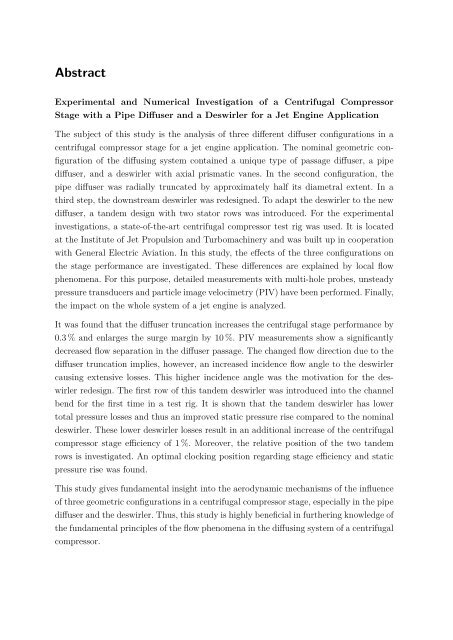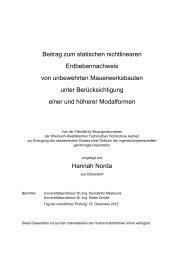Dokument 1.pdf - RWTH Aachen University
Dokument 1.pdf - RWTH Aachen University
Dokument 1.pdf - RWTH Aachen University
Sie wollen auch ein ePaper? Erhöhen Sie die Reichweite Ihrer Titel.
YUMPU macht aus Druck-PDFs automatisch weboptimierte ePaper, die Google liebt.
Abstract<br />
Experimental and Numerical Investigation of a Centrifugal Compressor<br />
Stage with a Pipe Diffuser and a Deswirler for a Jet Engine Application<br />
The subject of this study is the analysis of three different diffuser configurations in a<br />
centrifugal compressor stage for a jet engine application. The nominal geometric configuration<br />
of the diffusing system contained a unique type of passage diffuser, a pipe<br />
diffuser, and a deswirler with axial prismatic vanes. In the second configuration, the<br />
pipe diffuser was radially truncated by approximately half its diametral extent. In a<br />
third step, the downstream deswirler was redesigned. To adapt the deswirler to the new<br />
diffuser, a tandem design with two stator rows was introduced. For the experimental<br />
investigations, a state-of-the-art centrifugal compressor test rig was used. It is located<br />
at the Institute of Jet Propulsion and Turbomachinery and was built up in cooperation<br />
with General Electric Aviation. In this study, the effects of the three configurations on<br />
the stage performance are investigated. These differences are explained by local flow<br />
phenomena. For this purpose, detailed measurements with multi-hole probes, unsteady<br />
pressure transducers and particle image velocimetry (PIV) have been performed. Finally,<br />
the impact on the whole system of a jet engine is analyzed.<br />
It was found that the diffuser truncation increases the centrifugal stage performance by<br />
0.3 % and enlarges the surge margin by 10 %. PIV measurements show a significantly<br />
decreased flow separation in the diffuser passage. The changed flow direction due to the<br />
diffuser truncation implies, however, an increased incidence flow angle to the deswirler<br />
causing extensive losses. This higher incidence angle was the motivation for the deswirler<br />
redesign. The first row of this tandem deswirler was introduced into the channel<br />
bend for the first time in a test rig. It is shown that the tandem deswirler has lower<br />
total pressure losses and thus an improved static pressure rise compared to the nominal<br />
deswirler. These lower deswirler losses result in an additional increase of the centrifugal<br />
compressor stage efficiency of 1 %. Moreover, the relative position of the two tandem<br />
rows is investigated. An optimal clocking position regarding stage efficiency and static<br />
pressure rise was found.<br />
This study gives fundamental insight into the aerodynamic mechanisms of the influence<br />
of three geometric configurations in a centrifugal compressor stage, especially in the pipe<br />
diffuser and the deswirler. Thus, this study is highly beneficial in furthering knowledge of<br />
the fundamental principles of the flow phenomena in the diffusing system of a centrifugal<br />
compressor.
















